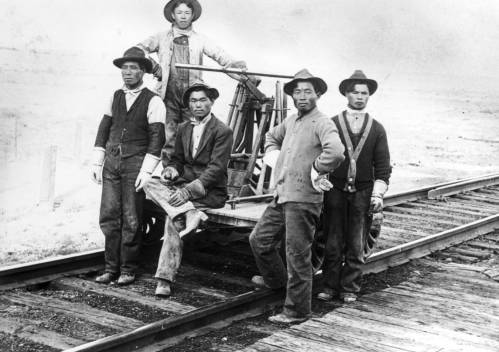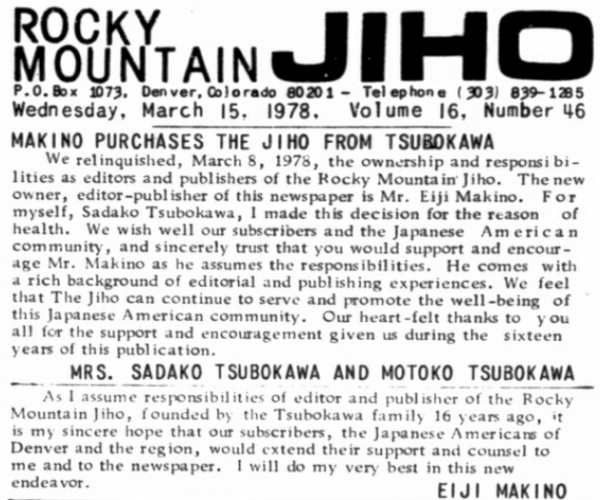The Colorado Historic Newspapers Collection (CHNC) recently added the Rocky Mountain JIHO, 1969-1997, to the 650+ publications included in the free-to-use online database. First published in 1962, the JIHO documents Japanese immigration and Japanese American community life in Denver and the surrounding area, from 1962 to 2006 when the paper closed.

By the late 1800s, the first Japanese people had arrived in Colorado. Many worked on the railroad and did not settle long, moving on as the work did. During the preceding decades the Japanese population grew in and around Denver as many settled and began farming or starting their own businesses. Many of the businesses were concentrated on Larimer Street in downtown Denver because Japanese weren’t allowed to open businesses in other parts of the city.
During WWII many Japanese people settled in Colorado to avoid West Coast incarceration, while others (many of them also from the West Coast) were forced to relocate and incarcerated in Camp Amache. Also known as the Granada Relocation Center, located near Granada, Colorado, Amache was one of ten incarceration sites established by the War Relocation Authority during World War II to unjustly imprison Japanese-Americans. Over 10,000 people, mostly American citizens, were incarcerated at Amache from 1942-1945.


After the war, with no homes or business to return to on the West coast, the Japanese population in and around Denver grew again as released prisoners remained in Colorado. The new residents found an established community and settled in the original Larimer Street area (also known as Nihonmachi or Japantown), but also pushed into the Five Points area and all the way east to City Park. Living, working, studying, and worshiping in close proximity made for a tight-knit community.

With community growth came the establishment of Kenjinkai – associations for people from the same prefecture – and other social and cultural infrastructure such as places of worship, as well as newspapers. The Sakura Square development, between Lawrence and Larimer Streets and 19th and 20th Streets, served as the center of these establishments and the community. Located near the square was the Japanese Association of Colorado (renamed the Japan America Society of Colorado) and the Denver Buddhist Temple established in 1916.

Several newspapers served the Japanese community in the decades leading up to WWII including the Rocky Shimpo and the Colorado Times. By the 1970s, the only newspaper serving the community was the Rocky Mountain Jiho, a weekly. The paper was owned and operated by Toshio and Sadako Tsubokawa, beginning with its first issue in 1962 through 1979. Toshio was a veteran journalist who, after graduating from the University of Denver, returned to Japan and joined Yomiuru, one of Japan’s largest newspapers. The Tsubokawas returned to Colorado and began publishing the JIHO’s short-lived predecessor the Rocky Mountain Journal in early 1962. The JIHO was truly a family operation. Sadako handled the local business advertisements and daughters Hiroko and Matoko helped their father with the weekly printing and distribution – sometimes working for 3 days straight and traveling to different states to deliver copies to the over 2,000 readers.
The JIHO was devoted almost entirely to local community news with articles in both English and Japanese. As an important source of information, it bound the community, near and far, together. The dual language pleased the first generation subscribers as well as the second generation subscribers who were largely fluent in English. Fumie Ogawa, one of the original typists, was largely responsible for the articles typed in Japanese characters while Roy and Sumi Takeno were responsible for the English translation of the articles.

Sadly, Toshio died on July 14, 1970 and Sadako struggled to keep the paper going. In 1978 she sold the JIHO to Eiji Makino who served on the staff of Bungei Shunju in Tokyo and published his own magazine. Six months later, after the passing of Makino, the paper was sold to Eiichi and Yoriko Imada, a young Japanese immigrant couple with no previous experience in publishing. The couple successfully published out of a Sakura Square office until it closed in 2006.

Dual language newspapers and especially Japanese language newspapers pose a unique challenge for OCR (Optical Character Recognition) and online access. CHNC uses OCR software to generate searchable text from an image of that text. OCR enables searching of large quantities of full-text data, but it is never 100% accurate. The Japanese writing system uses separate character sets as a way to represent words in writing. Hiragana and Katakana, collectively called “kana,” are two separate, phonetic sets of characters. Kanji, another set, are Chinese characters adapted and applied to Japanese. Together these sets constitute well over 3,000 characters. While much of the OCR work is computer generated there often needs to be a fair amount of human intervention to deal with the nuances of the language. A lack of Japanese language knowledge makes correcting the text challenging. Japanese text is also not separated by delimiters, such as spaces, and many characters have similar shape definition which adds to the lack of precision of the machine generated text.

Nevertheless, we are up for the challenge and the CHNC is thrilled to increase access to this important community newspaper. So much so that we will be adding more issues of the JIHO in the coming months. The current issues in CHNC were digitized from microfilm from History Colorado’s collection who also hold the originals of these issues. The Western History & Genealogy department at the Denver Public Library (DLP) holds originals of the JIHO from 1962 to 1965 and 1998 to 2006. DPL is graciously allowing the CHNC to digitize these originals. So be sure to check the CHNC often for these forthcoming additions. In the meantime……Happy Searching!

- 2025 Support for Newspaper Digitization - November 13, 2024
- An Appreciation of the Colorado Historic Newspapers Collection - November 4, 2024
- “Journalism is the first rough draft of history” – Philip L. Graham - October 23, 2024